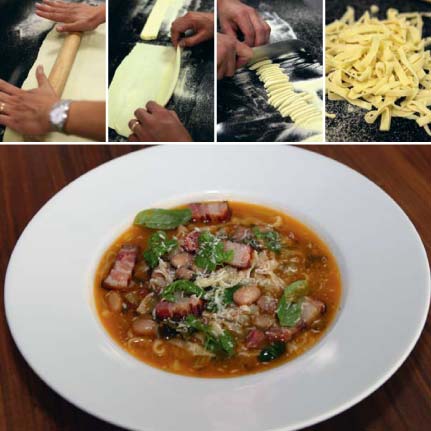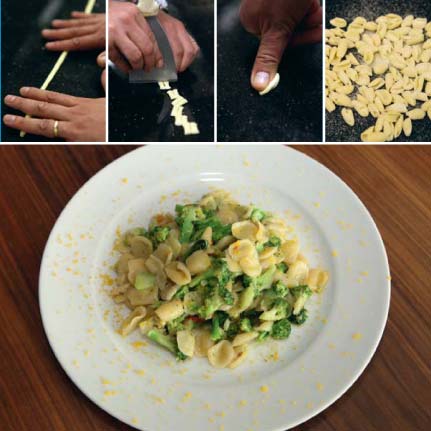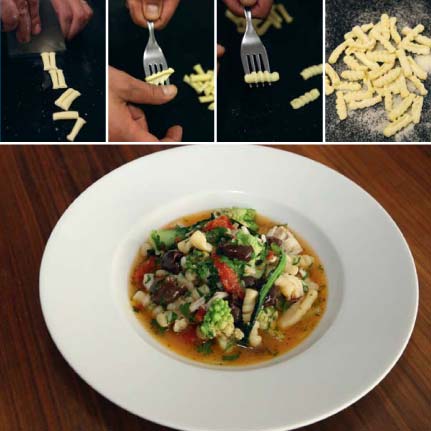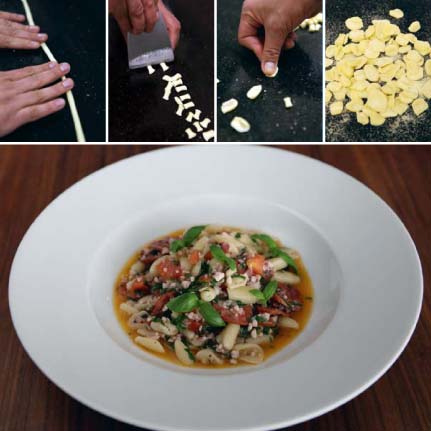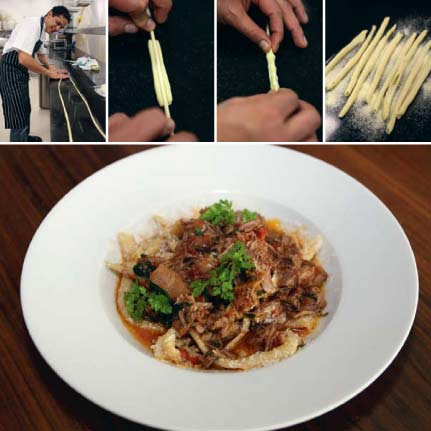Fresh pasta, southern Italian-style – A masterclass with Francesco Mazzei
Francesco Mazzei explains the art of making fresh pasta without eggs, the traditional southern Italian way, for maximum flavour absorption. Michael Raffael finds out more
Fresh pasta, made without eggs is part of the traditional culture of southern Italy and Sardinia. Knowing how to prepare it was once a skill practised in every household. Preparing it by hand seems time-consuming at first, but it quickly becomes second nature.
In one respect it's better suited to sauced pasta dishes than its northern sister enriched with eggs. The latter uses 00 flour that's less grainy, so sauces don't cling to it as well. A good eggless dough made from durum wheat semolina absorbs flavours better. "Good pasta," says Francesco Mazzei, "should always taste of the sauce."
FARINA DI SEMOLA RIMACINATA (sold as "Rimacinato")
Flour from this hard wheat has a protein content of about 11.5%. Durum wheat (triticum durum) is milled to make what we know as semolina and then re-ground. It has a rougher texture than other flours, making it ideal for pasta because it helps finished pasta to absorb sauces or soups.
Francesco Mazzei buys 30kg sacks from Italian miller Spadoni that cost about £22.
BASIC DOUGH
L'Anima may serve upwards of 250 pasta portions per day, so it makes 10kg batches. The quantities can be scaled up from a recipe based on 1kg of flour.
The quantity of water given here is approximate. Never add all the water at once. Keep a little back until the kneading is well underway so you don't have to adjust the flour content.
INGREDIENTS
1kg Rimacinato flour
1tsp salt
420ml water at 28°C to 30°C (the temperature is critical)
METHOD Put the flour in a mixing bowl. Dissolve the salt in the tepid water.
Add about two-thirds of the water to the dough and start kneading by hand or in the machine (dough hook is best). Add almost all the remaining water and continue kneading for about 15 minutes to obtain a stiff, perfectly smooth dough. Only add the last of the water if necessary.
The dough forms a firm, almost rubbery block. Cover with a slightly damp cloth and rest for at least two hours.
To tell whether it is ready to use, press your thumb hard into the dough. The imprint should not start to spring back.
When rolling and shaping the pasta, work on a cool surface.
BASIC ADVICE FOR COOKING FRESH PASTA WITHOUT EGG
â- Don't expect to cook to precise times. The sooner you cook the pasta after making it, the shorter the time will be. It will, however, take longer than egg noodles.
â- The term "al dente" can be misleading. Three-quarter cook the pasta in boiling water, then finish it in the sauce with which it will be served.
â- A little of the cooking liquid added to the sauce is OK - you may transfer the pasta from water to sauce with a spider without draining it.
â- At L'Anima the kitchen operates with two pasta boilers. When the water in one becomes too starchy, the chefs switch to the second because starchy water makes for sticky, unpleasant pasta.
LAGANE
From Basilicata, these are one of the earliest recorded pasta shapes. Finely shredded, they are added to soups or served with chickpeas.
Roll out 120g-150g pasta dough on the machine (about 3 on most modern machines). Transfer the dough to a work surface dusted with Rimacinato flour. Pin it out so it almost doubles its length. Divide into two strips and lay them alongside each other. Dust with more flour, then roll each piece up like a Swiss roll. Shred finely, so each piece is about 4mm diameter.
Cooking time: boil for 3 to 4 minutes and add to soups.
LAGANE IN A BORLOTTI BEAN AND GUANCIALE SOUP
Guanciale is dry-cured pig's cheek. The soup is a mixture of beans, tomato, courgettes, basil and guanciale cooked in brodo vegetale (vegetable stock). Before serving, the pieces of guanciale are removed, seared on a griddle and chopped. Simmer par-boiled lagane in the soup and add the guanciale back at the last minute.
ORECCHIETTE
These "little ears" are a speciality of Puglia. They are made in a similar way to cavatelli, but are a bit larger and have a slightly different shape.
You'll find it easier if you work with pieces of dough weighing between 60g and 80g. The exact weight is unimportant.
Put the piece of dough on the work surface. Treat it as if it were a rolling pin or play dough that gets longer and longer as you roll it back and forth. Keep rolling until you have a dough string that's about 60cm long.
Put the two ends together and cut the dough in half in the middle. Cut the two pieces into small nuggets about a centimetre long and a scant half-centimetre in diameter.
To shape one: using the length of the pasta nugget as a guide, press downwards with your thumb, then from side to side to obtain a kind of ear shape.
Cooking time: up to 10 minutes in boiling water.
ORECCHIETTE, CALABRESE AND BOTTARGA
There are two little-known but highly prized ingredients in this recipe. Anchovy water (colatura di alici) is fermented for five months and gives a special zing to the dish - somewhat like Thai shrimp paste. The bottargo, dried mullet roe, has a powerful, mouth-filling taste.
Simmer calabrese (broccoli) florets with anchovies, chilli and the par-boiled orecchiette with a little of its cooking water. Flavour the dish with crushed anchovy, oil and garlic, and shake the pan to create a light emulsion. For service, sprinkle a little grated bottarga over the plate.
MALLOREDDUS
This Sardinian pasta shapes translates as "chubby little bulls". You need a fork to shape them.
Put a 60g lump of dough on the work surface. Treat it as if it were a rolling pin or play dough that gets longer and longer as you roll it back and forth. Keep rolling until you have a dough string that's about 60 cm long.
Put the two ends together and cut the dough in half in the middle. Cut the two pieces into small nuggets about as long as the end of your fork is wide.
To shape one: you need the tines of the fork to be pointing upwards. Put a piece of dough on the fork where it joins the handle and roll it down to the end, pressing firmly enough to make the pasta look like a series of rings.
Cooking time: up to 12 minutes in boiling water.
MALLOREDDUS WITH SKATE IN ANCHOVY WATER
Cook pieces of boned skate in olive oil with cherry tomatoes, a hint of chilli and a little stock. Add part-cooked malloreddus and blanched romanescu florets to the pan. When they've finished cooking, add a little olive oil and some stoned black taggiasca olives.
CAVATELLI
The word derives from the Italian for a cave. When making these "cavelets", think of a hollowed-out shape -slightly more, slightly less according to the way your fingers work.
You'll find it easier if you work with pieces of dough weighing between 60g and 80g. The exact weight is unimportant.
Put the piece of dough on the work surface. Treat it as if it were a rolling-pin or play dough that gets longer and longer as you roll it back and forth. Keep rolling until you have a dough string that's about 60cm long.
Put the two ends together and cut the dough in half in the middle. Cut the two pieces into small nuggets about half a centimetre long.
To shape one: flatten it with your thumb, allowing the edges to curl up on either side so each one is slightly cupped. To store, place on a rack or tray dusted with flour. Cover with a slightly damp cloth. Use the same day.
Cooking time: cook in boiling salted water. The time will vary from four minutes upwards depending on the thickness of the cavatelli, their freshness and whether they've dried out during storage.
CAVATELLI WITH OCTOPUS RAGU
Simmer the octopus for 90 minutes, then chill and finely chop it so the bits are like dried couscous grains. Combine it with a sauce of sausage (like chorizo), garlic, shallots, fresh marjoram, a hint of chilli and tomato sugo. Add the cavatelli to the stew and, before service, sprinkle a touch of olive oil and some grated pecorino over each portion.
FILEI (FILEJA OR FILEDA)
A bit like handmade macaroni, this Calabrian pasta probably means something that's been threaded because it's hollow like the eye of a needle. You need to work with a thick wooden skewer/brochette.
Roll out a 150g block of dough in the same way as for the cavatelli, but it's going to form a cord almost two metres long. Put the ends together. Cut the cord into two. Divide each one into lengths of approximately 8cm.
To shape one: lay a piece of dough along the length of the skewer. Press the skewer down a little and turn it around. Squeeze the pasta together along its length to seal it. Roll it out on the work surface and remove the skewer. (Don't expect each one to be perfect - it doesn't matter)
Cooking time: boil for 5-8 minutes.
FILEI WITH LAMB RAGU
Cook lamb ragÁ¹, flavoured with juniper, Calabrian dried oregano, basil and red wine, until the lamb is tender enough to be flaked with a fork. Add part-cooked filei to the sauce to finish cooking. For service, add a few mint leaves and grated pecorino sardo to the plate.
WINE PAIRING
For all the dishes except the orecchiette, Franceso Mazzei would recommend a non-filtered organic rosato made in CirÁ², with a typical Calabrian grape, gaglioppo.
The flavour of bottargo is so strong and lingering that he suggests a 2006 Barbera (Oltrepo Pavese) from Gravello.
PASTA ON L'ANIMA MENU
Francesco Mazzei aims for a 28% food cost in his kitchen. ‘Primi' sell from £8.50 for minestrone to £23 for pappardelle with lobster. Portion sizes for half of these can be either as starters or as main courses.
FRANCESCO MAZZEI
Earning money in a Calabrian gelateria, aged eight, partner in a restaurant at 18, Francesco Mazzei can honestly claim to have spent most of his 38 years in kitchens.
He has brought southern Italian cooking to London with a flair that has brought him a string of awards. In 2009 he won five including Time Out's Best New Italian and Harden's Remy Martin Excellence Award.
His L'Anima restaurant in Shoreditch has just finished a makeover that increases its seating to 140 including an eat-at-the bar section. And, together with Alan Yau's sister Linda, he has a share in a Marylebone deli, Cocorino, which stocks the pick of south Italy's produce.
Photography by Lisa Barber (www.lisabarber.co.uk)
Continue reading
You need to be a premium member to view this. Subscribe from just 99p per week.
Already subscribed? Log In


